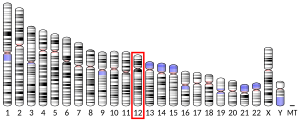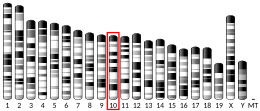SWI/SNF complex subunit SMARCC2 is a protein that in humans is encoded by the SMARCC2 gene .[ 5] [ 6] [ 7]
The protein encoded by this gene is a member of the SWI/SNF family of proteins, whose members display helicase and ATPase activities and which are thought to regulate transcription of certain genes by altering the chromatin structure around those genes. The encoded protein is part of the large ATP-dependent chromatin remodeling complex SNF/SWI and contains a predicted leucine zipper motif typical of many transcription factors. Two transcript variants encoding different isoforms have been found for this gene.[ 7]
^ a b c GRCh38: Ensembl release 89: ENSG00000139613 – Ensembl , May 2017^ a b c GRCm38: Ensembl release 89: ENSMUSG00000025369 – Ensembl , May 2017^ "Human PubMed Reference:" . National Center for Biotechnology Information, U.S. National Library of Medicine .^ "Mouse PubMed Reference:" . National Center for Biotechnology Information, U.S. National Library of Medicine .^ Wang W, Xue Y, Zhou S, Kuo A, Cairns BR, Crabtree GR (November 1996). "Diversity and specialization of mammalian SWI/SNF complexes" . Genes Dev . 10 (17): 2117–30. doi :10.1101/gad.10.17.2117 PMID 8804307 . ^ Ring HZ, Vameghi-Meyers V, Wang W, Crabtree GR, Francke U (September 1998). "Five SWI/SNF-related, matrix-associated, actin-dependent regulator of chromatin (SMARC) genes are dispersed in the human genome" . Genomics . 51 (1): 140–3. doi :10.1006/geno.1998.5343 PMID 9693044 . ^ a b "Entrez Gene: SMARCC2 SWI/SNF related, matrix associated, actin dependent regulator of chromatin, subfamily c, member 2" .^ Wang W, Côté J, Xue Y, Zhou S, Khavari PA, Biggar SR, Muchardt C, Kalpana GV, Goff SP, Yaniv M, Workman JL, Crabtree GR (October 1996). "Purification and biochemical heterogeneity of the mammalian SWI-SNF complex" . EMBO J . 15 (19): 5370–82. doi :10.1002/j.1460-2075.1996.tb00921.x . PMC 452280 PMID 8895581 . ^ Otsuki T, Furukawa Y, Ikeda K, Endo H, Yamashita T, Shinohara A, Iwamatsu A, Ozawa K, Liu JM (November 2001). "Fanconi anemia protein, FANCA, associates with BRG1, a component of the human SWI/SNF complex" . Hum. Mol. Genet . 10 (23). England: 2651–60. doi :10.1093/hmg/10.23.2651 ISSN 0964-6906 . PMID 11726552 . ^ Zhao K, Wang W, Rando OJ, Xue Y, Swiderek K, Kuo A, Crabtree GR (November 1998). "Rapid and phosphoinositol-dependent binding of the SWI/SNF-like BAF complex to chromatin after T lymphocyte receptor signaling" . Cell . 95 (5): 625–36. doi :10.1016/S0092-8674(00)81633-5 PMID 9845365 . S2CID 3184211 .
Wang W, Côté J, Xue Y, Zhou S, Khavari PA, Biggar SR, Muchardt C, Kalpana GV, Goff SP, Yaniv M, Workman JL, Crabtree GR (1996). "Purification and biochemical heterogeneity of the mammalian SWI-SNF complex" . EMBO J . 15 (19): 5370–82. doi :10.1002/j.1460-2075.1996.tb00921.x . PMC 452280 PMID 8895581 . Wang W, Chi T, Xue Y, Zhou S, Kuo A, Crabtree GR (1998). "Architectural DNA binding by a high-mobility-group/kinesin-like subunit in mammalian SWI/SNF-related complexes" . Proc. Natl. Acad. Sci. U.S.A . 95 (2): 492–8. Bibcode :1998PNAS...95..492W . doi :10.1073/pnas.95.2.492 PMC 18447 PMID 9435219 . Cho H, Orphanides G, Sun X, Yang XJ, Ogryzko V, Lees E, Nakatani Y, Reinberg D (1998). "A Human RNA Polymerase II Complex Containing Factors That Modify Chromatin Structure" . Mol. Cell. Biol . 18 (9): 5355–63. doi :10.1128/MCB.18.9.5355 . PMC 109120 PMID 9710619 . Phelan ML, Sif S, Narlikar GJ, Kingston RE (1999). "Reconstitution of a core chromatin remodeling complex from SWI/SNF subunits" . Mol. Cell . 3 (2): 247–53. doi :10.1016/S1097-2765(00)80315-9 PMID 10078207 . Bochar DA, Wang L, Beniya H, Kinev A, Xue Y, Lane WS, Wang W, Kashanchi F, Shiekhattar R (2000). "BRCA1 is associated with a human SWI/SNF-related complex: linking chromatin remodeling to breast cancer" . Cell . 102 (2): 257–65. doi :10.1016/S0092-8674(00)00030-1 PMID 10943845 . S2CID 6500100 . Kadam S, McAlpine GS, Phelan ML, Kingston RE, Jones KA, Emerson BM (2000). "Functional selectivity of recombinant mammalian SWI/SNF subunits" . Genes Dev . 14 (19): 2441–51. doi :10.1101/gad.828000 . PMC 316972 PMID 11018012 . Xue Y, Canman JC, Lee CS, Nie Z, Yang D, Moreno GT, Young MK, Salmon ED, Wang W (2001). "The human SWI/SNF-B chromatin-remodeling complex is related to yeast Rsc and localizes at kinetochores of mitotic chromosomes" . Proc. Natl. Acad. Sci. U.S.A . 97 (24): 13015–20. Bibcode :2000PNAS...9713015X . doi :10.1073/pnas.240208597 PMC 27170 PMID 11078522 . Sif S, Saurin AJ, Imbalzano AN, Kingston RE (2001). "Purification and characterization of mSin3A-containing Brg1 and hBrm chromatin remodeling complexes" . Genes Dev . 15 (5): 603–18. doi :10.1101/gad.872801 . PMC 312641 PMID 11238380 . Kato H, Tjernberg A, Zhang W, Krutchinsky AN, An W, Takeuchi T, Ohtsuki Y, Sugano S, de Bruijn DR, Chait BT, Roeder RG (2002). "SYT associates with human SNF/SWI complexes and the C-terminal region of its fusion partner SSX1 targets histones" . J. Biol. Chem . 277 (7): 5498–505. doi :10.1074/jbc.M108702200 hdl :2066/170683 PMID 11734557 . Battaglioli E, Andrés ME, Rose DW, Chenoweth JG, Rosenfeld MG, Anderson ME, Mandel G (2002). "REST repression of neuronal genes requires components of the hSWI.SNF complex" . J. Biol. Chem . 277 (43): 41038–45. doi :10.1074/jbc.M205691200 PMID 12192000 . Olave I, Wang W, Xue Y, Kuo A, Crabtree GR (2002). "Identification of a polymorphic, neuron-specific chromatin remodeling complex" . Genes Dev . 16 (19): 2509–17. doi :10.1101/gad.992102 . PMC 187451 PMID 12368262 . Nie Z, Yan Z, Chen EH, Sechi S, Ling C, Zhou S, Xue Y, Yang D, Murray D, Kanakubo E, Cleary ML, Wang W (2003). "Novel SWI/SNF Chromatin-Remodeling Complexes Contain a Mixed-Lineage Leukemia Chromosomal Translocation Partner" . Mol. Cell. Biol . 23 (8): 2942–52. doi :10.1128/MCB.23.8.2942-2952.2003 . PMC 152562 PMID 12665591 . Kitagawa H, Fujiki R, Yoshimura K, Mezaki Y, Uematsu Y, Matsui D, Ogawa S, Unno K, Okubo M, Tokita A, Nakagawa T, Ito T, Ishimi Y, Nagasawa H, Matsumoto T, Yanagisawa J, Kato S (2003). "The chromatin-remodeling complex WINAC targets a nuclear receptor to promoters and is impaired in Williams syndrome" . Cell . 113 (7): 905–17. doi :10.1016/S0092-8674(03)00436-7 PMID 12837248 . (Retracted, see doi :10.1016/j.cell.2012.03.008 , PMID 22464333 , Retraction Watch . If this is an intentional citation to a retracted paper, please replace {{retracted |...}} with {{retracted |...|intentional=yes}}. ) Hsiao PW, Fryer CJ, Trotter KW, Wang W, Archer TK (2003). "BAF60a Mediates Critical Interactions between Nuclear Receptors and the BRG1 Chromatin-Remodeling Complex for Transactivation" . Mol. Cell. Biol . 23 (17): 6210–20. doi :10.1128/MCB.23.17.6210-6220.2003 . PMC 180928 PMID 12917342 . Bouwmeester T, Bauch A, Ruffner H, Angrand PO, Bergamini G, Croughton K, Cruciat C, Eberhard D, Gagneur J, Ghidelli S, Hopf C, Huhse B, Mangano R, Michon AM, Schirle M, Schlegl J, Schwab M, Stein MA, Bauer A, Casari G, Drewes G, Gavin AC, Jackson DB, Joberty G, Neubauer G, Rick J, Kuster B, Superti-Furga G (2004). "A physical and functional map of the human TNF-alpha/NF-kappa B signal transduction pathway". Nat. Cell Biol . 6 (2): 97–105. doi :10.1038/ncb1086 . PMID 14743216 . S2CID 11683986 . Kuwabara T, Hsieh J, Nakashima K, Taira K, Gage FH (2004). "A small modulatory dsRNA specifies the fate of adult neural stem cells" . Cell . 116 (6): 779–93. doi :10.1016/S0092-8674(04)00248-X PMID 15035981 . S2CID 12656737 . Beausoleil SA, Jedrychowski M, Schwartz D, Elias JE, Villén J, Li J, Cohn MA, Cantley LC, Gygi SP (2004). "Large-scale characterization of HeLa cell nuclear phosphoproteins" . Proc. Natl. Acad. Sci. U.S.A . 101 (33): 12130–5. Bibcode :2004PNAS..10112130B . doi :10.1073/pnas.0404720101 PMC 514446 PMID 15302935 .





